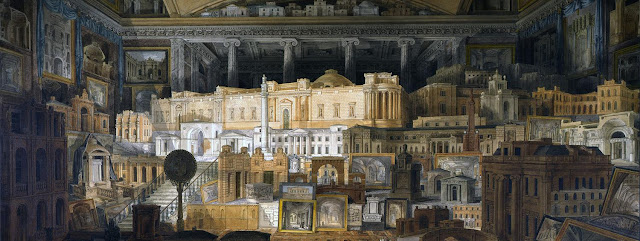HEAVENLY MANSIONS AND SACRED SPACES

We have been working on a range of paper textiles and folded forms that have been directed by our residency within Guildford Cathedral. Our work has taken on a new direction as we have introduced painting techniques and a vibrant colour palette to create geometric patterns within the origami crease patterns of our paper models. These new techniques have been directly influenced by our exposure to the design motifs and colour scheme - Guildford blue and gold - that are used throughout the Cathedral.
The folds used within our models are 'waterbomb' folds. This is a traditional Japanese origami base fold that can be used to create very complex folded models. The architecture of the waterbomb folds is very reminiscent of the folded ceiling within the main Cathedral that gives the interior space a powerful presence.
The title of our blog post 'Heavenly Mansions' is taken from an influentual book by the British architectural historian John Summerson published in 1963, following the completion of Guildford Cathedral. Summerson's book interprets architecture as a reflection of the age in which it flowers. The book traces the alternating themes of fantasy and functionalism exemplified in the various styles and works of a number of influential architects.
We have identified that many of Edward Maufe's inspirations embedded in his design outlook were possibly instilled during his formative years. Maufe spent the early part of his life living in the Red House, a purpose designed house completed in 1860 for William Morris, designed by the architect Philip Webb, as a Victorian re-interpetation of the English Gothic mansion. Edward Maufe worked in close partnership with his wife Prudence Maufe who oversaw many of the Cathedral's interior design elements such as the kneelers and rugs.
The interior design aesthetic within the Cathedral seems to have been influenced by Prudence's career as an interior designer and director for Heal's department store. Heal’s company design philosophy was influenced by the Arts and Crafts movement established by the iconoclastic Victorian designer and maker William Morris. One of the founding directors of Heal's department store was Ambrose Heal. Heal joined the company in 1893 having completed an apprenticeship as a cabinet maker. Ambrose Heal believed in modernity and combined this functional aestheticism with a conviction that affordable furniture produced in large-scale workshops could still be of a good quality. Heal also firmly believed in the dictum advocated by William Morris, that everyone should,
“Have nothing in your house that you do not know to be useful, or believe to be beautiful.”
The creative partnership between Edward and Prudence Maufe has proved to be a very inspiring theme within this residency. On a personal level we can identify with their working relationship, as it mirrors our own practice within architecture and textiles. As professional designers we can appreciate that their complimentary design skills transform the Cathedral into a total work of art.
 |
Edward and Prudence Maufe |







Comments
Post a Comment